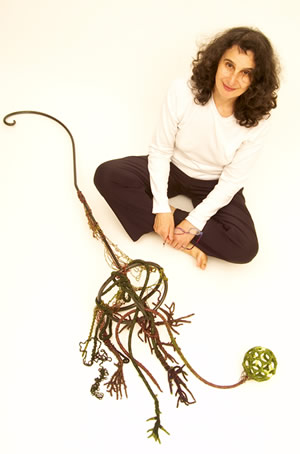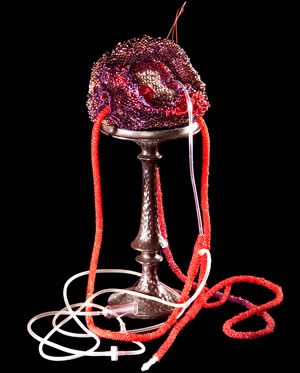UNCHARTED WATERS by Pam O'Connor It doesn't take long to realize that Gail Gorlitzz is game for anything. She fairly hums with energy, and her conversation moves nimbly from the pros and cons of various beading threads to the brain chemistry of teenagers. This enormous appetite for life is also clearly evident in her beaded artwork. "When I start a piece, I set a problem for myself, an issue to work out," she explains. "As it progresses, something unexpected must emerge to engage me . . . If the work doesn't have that, I destroy it or change it utterly." This "take-no-prisoners" approach to her work was evident in a recent one-woman show at the Glass Gallery in Bethesda, Maryland. Vividly imagined and boldly colored, the collection of works taps into a creative sensibility at turns witty, poignant, and surreal. Indeed, Gorlitzz's work expressly eschews pat forms or pretty finesses. You might anticipate a work with the title Precious to be diminutive and, perhaps, smack of the banal. You'd be wrong. This impressively large piece stands over 3 ft. (.9m) tall. At first glance, its shapely, burnished-gold contours suggest an elegant Fortuny lamp. But look again and you're in uncharted waters. Unruly freeform elements stake out territory around the form's middle, and a mad outcropping of organic embellishments that appear to be barnacles below a rumbled and spiny cap, top the piece. A tail-like rope spirals from the form around the cage-like metal base (originally a lampshade frame). With its wild wraps and a color gradation that intensifies to deep purple, it both echoes and critiques the staid curvilinear shape above it. |
|
|
Evolving Interests "I had always been a collector of beads, but when I began using them in my work, I realized that they satisfied a need that I had," she explains. "The work of a wood carver is subtractive, you are taking away to achieve your end, but beading is additive. The process allows me to work more intuitively. And the movement of adding the beads has a flow which I find creatively exciting." While she has a bachelor of fine arts degree in sculpture from Cornell University, as well as a master's degree in education, Gorlitzz is, like many, self-taught when it comes to beading. "I never took a class," she admits. "The closest I ever came was going to a lecture by Joyce Scott. It was her book (Fearless Beadwork: Improvisational Peyote Stitch: Handwriting & Drawings from Hell) that I used as a guide when I was taught myself peyote stitch." |
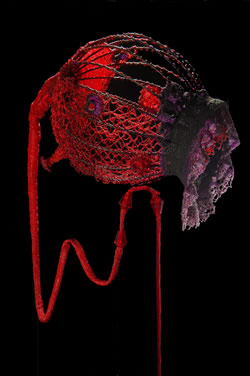 |
Driven by color "Much of my work with beads is driven by color. I am constantly surprised by by how the colors change and how layering colors transforms a piece," she asserts. Progressions in hue and clashes of color energize the undulating vines of Babylon I and II. But the flexibility of the form -- that there is no set way to display the pieces-- is also a trait Gorlitzz cultivates "I like the fluidity and flexibility of beadwork, it's changeability -- whether in the way light affects the colors or in the malleability of the stitched form," she says, encouraging me to touch her pieces. The Babylon works obviously reference the famous hanging gardens of the biblical city, but also her own long-standing love of the natural world. |
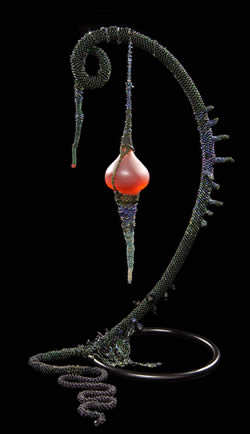 |
 |
Magic and humor rded and domestic take on enchanted roles in many of Gorlitzz's works. In Scheherezade, a lamp base and the stopper from a decanter are magically transformed into a meditation on the most famous of female storytellers. Her life literally hangs by her narrative thread as the ripe shape of the wine stopper -- encased in beadwork and suspended by a crystal-embellished strand -- suggests. A glittering tail (or tale) winds around the base of the graceful arabesque from which the stopper is suspended. Gorlitzz's wit and sense of play have even larger expression in Significant Other. "I love to include jokes and tricks in my work," she says with a twinkle in her eye, before asking me to squeeze the silicone "implant" inside one of the appendages of this saucy piece. Here, the circular, black metal armature is largely exposed and contrasts with the lacy lingerie look of the beading. Both ends of the armature have intensely beaded centers. Of course, its shape suggests a breast, but the long snake-like appendage emanating from one end indicates otherwise. The two intensely beaded poles, one red, one black and purple, are connected by a beaded network that seems to reference fishnet stockings and nerve synapses simultaneously. Gorlitzz is clearly having a bit of wicked fun. |
|
Surreal and unflinching By choosing beadwork to speak her mind, Gorlitzz invigorates the medium, dispelling old biases and inviting us to rethink our expectations. With drama and humor, she engages us and gives beads and thread consequence. |
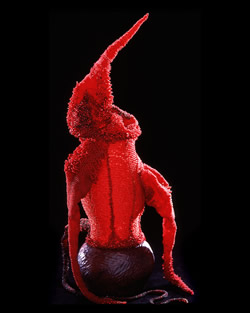 |
| Gail Gorlitzz's work will be on display at the McLean Project for the Arts in McLean, Virginia, from December 6, 2005 to January 14, 2006. For more information, visit her website: www.gailgorlitzz.com. |
||
